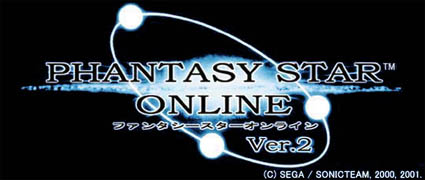For 
Distributed by
Sega
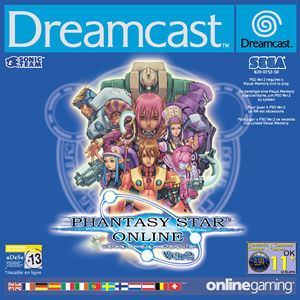
- Price: £29.99 (for UK version)
- Players: 1-online
The following is a review of the Japanese imported version of this game, although the UK version is now available without a financial requirement to play online.
PSOv2 is the much-awaited ‘update’ to Phantasy Star Online – not a sequel as such, more of an enhancement as it includes the entirity of the original game with some extras thrown in for good measure. Note, that it’s a stand-alone game – you don’t have to have owned/played PSO to play PSOv2.
I’ve personally spent a HUGE amount of time playing PSO since its US Launch in February 2001 (almost 500 hours!) and therefore when PSOv2 was released in Japan in early June I just had to be amongst the first online!
Pay to Play
Unlike the US and UK releases of PSO, Japanese PSO requires you to pay for a ‘Hunters Licence’ to gain online access. I understand that the US release of PSOv2 (due in August) will have a similar ‘pay-to-play’ system. All I can say is that I hope it’s as reasonable as the Japanese system which costs a mere $9 (£6ish) for 90 days access…
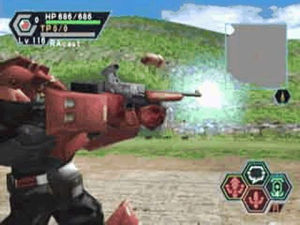 What’s New – Offline Mode
What’s New – Offline Mode
Nothing new here until you beat Dark Falz on Very-Hard mode at which point you gain access to Ultimate Mode. More on this on the Online section below…
What’s New – Online Mode
The good news is that PSOv2 players can mingle and play with PSO players as before, although any V2-specific items they’ve found will disappear from their inventories whilst they’re playing outside V2-specific games for obvious reasons.
To find and/or use the new items or play the new game modes, PSOv2 players must create a V2-specific game. These games are ‘invisible’ to PSO players although they’re on the same ships and can be in the same lobbies. PSOv2 players also have access to new lobbies on each ship though (11 upwards) which are where ‘Chu Chu Football’ is played.
There are also 3 new modes in PSOv2 – Challenge, Battle and Ultimate.
Challenge mode requires at least 2 players (max of 4). Each time you start a Challenge Stage you are reset to Level 1 with a minimal inventory. The ‘Challenge’ is to survive and find items as you go – you cannot transport back for supplies and there are a LOT of monsters to kill as well as puzzles and co-operative problems to solve. The game continues until ANY player dies at which point its game over, so co-operation and planning are required to complete a Stage successfully.
Battle Mode is a ‘Quake Deathmatch’ Player-versus-Player competition with 4 different sets of ‘rules’ determining what items can be taken into the arenas, how long the game lasts and what the objectives are. The arenas are all new levels called Spaceship and Temple which are exclusive to Battle Mode. They are quite large and ‘windy’ with lots of hiding places and warps to keep your enemies guessing.
Ultimate Mode is set in ‘remixed’ versions of the existing levels and is where all your new weapons, items, monsters and bosses are to be found. Put simply, Ultimate Mode is TOUGH and serious effort is required to progress. The new weapons are, of course, much more powerful, but they’re only found in Ultimate Mode of course, so there’s some ‘chicken and egg’ going on here!
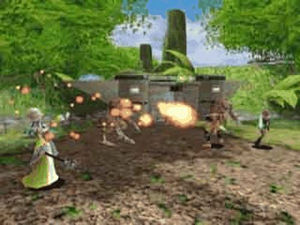 Other changes
Other changes
Characters can now develop upto Level 200. If you transfer over a character from PSO, any EXPerience you gained after L100 is wiped and you’re ready to start working through a further 100 levels. The requirements for gaining new levels are now VERY high though, so be prepared for a VERY long haul to Level 200!
There’s a new Quick-menu on the R&Y key (formerly the alternative Chat option) which brings up quick-lists of Weapons, Items and Techniques. It’s far from brilliant but it is quite handy – mostly for re-equipping a weapon after being revived or swapping weapons mid-melee.
If you save a game with at least 100,000 mesetas ‘in your pockets’, reloading will offer you the ‘Dressing Room’ option. In here you can change your Hair colour/Style and clothes but not your proportions or anything more ‘permanent’. The 100,000 mesetas are deducted on exit of course…
What you don’t get
There are no new character types or costumes, although the ‘hidden’ costumes from PSO are no longer ‘hidden’.
There are no new Techniques either, although it’s possible to get higher level techniques (16 upwards) if you’re a Force character (only).
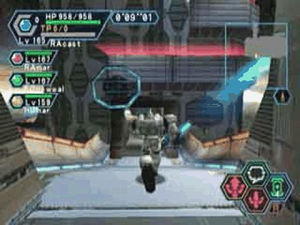 Summary
Summary
Ultimate Mode and the trek to L200 is going to be the main attraction of PSOv2. Certainly, most keen PSO players I know will be happy just to take their characters on through another 100 levels.
This is fortunate because the rest of the new features are a rather mixed-bag and none are outstanding additions to the original.
Challenge Mode is quite good fun and it adds some longevity to the game. The only downside really is that it’s time-consuming – with Stages taking at least 45 mins to complete and no mid-game save option.
Battle Mode is less impressive however, the problems are numerous but all come down to the fact that PSO was not designed with Player-vs-Player combat in mind. Sonic Team have tried to work around this but the result isn’t very special and won’t appeal to everyone – I certainly don’t enjoy it.
Chu Chu Football is just a gimmick really, but it could be entertaining for a short while perhaps 😉
All in all, I’m pretty happy with my copy of v2 and I will be picking up a US copy to take my existing characters on the trek to L200 in due course. With any luck, my Japanese character will have loads of new goodies for them by then too!
A note on the Import: I can’t really recommend the Import though, as existing players have to start from Level 1 again and all players have to put up with significant network-lag problems caused by connecting to Japanese Servers to play.
If you REALLY MUST import PSOv2, feel free to drop me an email by clicking on my name below and I’ll point you to the instructions I used to get online and running.
SOUND EFFECTS AND MUSIC
PLAYABILITY
ORIGINALITY
ENJOYMENT




















 OVERALL
OVERALL 



Email Zarjaz
Reviewer of movies, videogames and music since 1994. Aortic valve operation survivor from the same year. Running DVDfever.co.uk since 2000. Nobel Peace Prize winner 2021.

